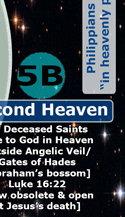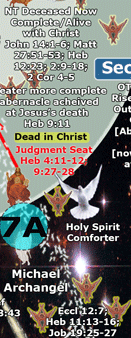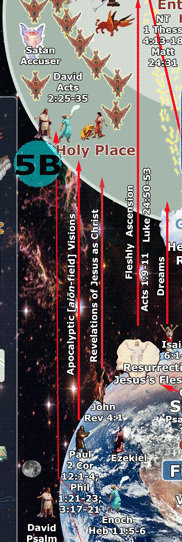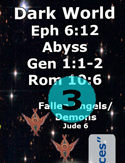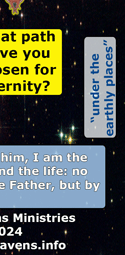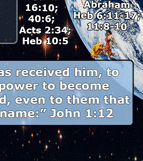
Content
Updated
12/25/2024
- Introduction to the mapping conversations about the ministry of Christ
- Visual Ministry of Christ Mapping (Interactive Chart)
- Visual Movement of Christ in the tabernacle of the heavens (2-4 Minute Videos)
- Visual Mapping the Revelation about Christ (Interactive Chart)
- Full menu of the 21 mapping conversations (Linked listing of number map conversations)
_____________________________________________________________________________
Introduction
The Role of Conversation for Others Coming to Faith
in Relation to Open Heavens Ministries
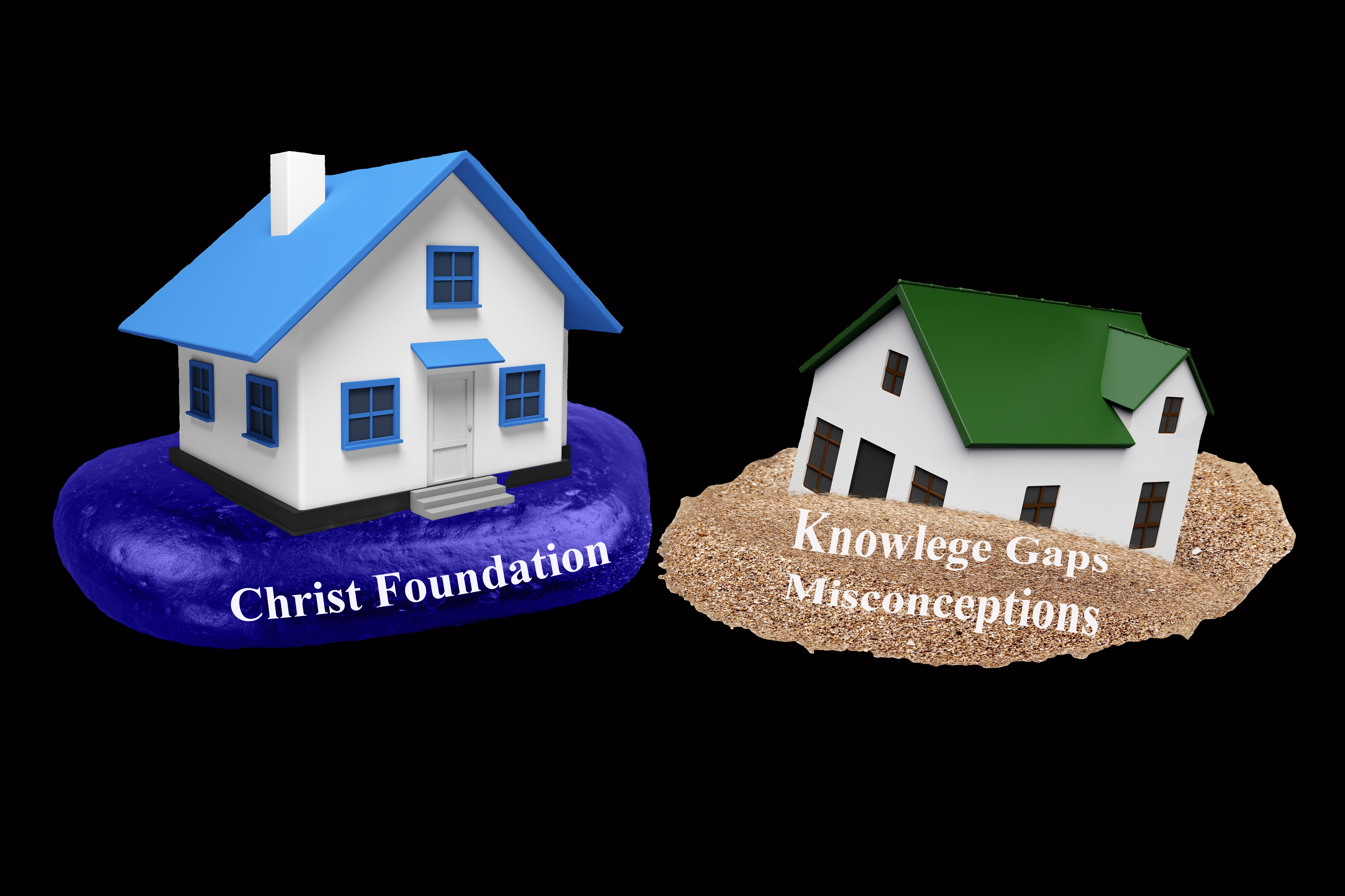 The Apostle Paul with his letter to the saints at Rome, provides extensive exposition about God's gospel calling to the Hellenistic Gentiles (Rom 1:1-8; 1:15-17). Paul had never been to Rome, but he had heard of the Gentile growth in faith (Acts 18:1-4). A key background concept, for understanding his terms and their relationship together, is that most people in the first century CE generally expected an experience of facing God at death and judgment, with salvation in continued living into God's presence for those found righteous by their faith in the ministry of Christ (Acts 10:42-43). He calls the information about this assured salvation experience at judgment, the "gospel," meaning "good news." He closes out his introductory thoughts and expresses gospel content and method, stating, "For righteousness of God in it [the gospel] is revealed from faith with the result [comes] faith, just as it has written, 'But the just will himself live by faith'" (Rom 1:17, translation mine). His point, faith in belief comes from others with faith, i.e. God's plan is that other people bring other people to Christ (cf. 1 Cor 3:9; Heb 3:1).
The Apostle Paul with his letter to the saints at Rome, provides extensive exposition about God's gospel calling to the Hellenistic Gentiles (Rom 1:1-8; 1:15-17). Paul had never been to Rome, but he had heard of the Gentile growth in faith (Acts 18:1-4). A key background concept, for understanding his terms and their relationship together, is that most people in the first century CE generally expected an experience of facing God at death and judgment, with salvation in continued living into God's presence for those found righteous by their faith in the ministry of Christ (Acts 10:42-43). He calls the information about this assured salvation experience at judgment, the "gospel," meaning "good news." He closes out his introductory thoughts and expresses gospel content and method, stating, "For righteousness of God in it [the gospel] is revealed from faith with the result [comes] faith, just as it has written, 'But the just will himself live by faith'" (Rom 1:17, translation mine). His point, faith in belief comes from others with faith, i.e. God's plan is that other people bring other people to Christ (cf. 1 Cor 3:9; Heb 3:1).
In Romans 10, as he explains Israel's ministerial unbelief in Jesus as the promised Christ, Paul further develops his preaching method and content concerning from faith the result [comes] faith. He switches from the word "gospel" to the Greek rhēma and calls the content of his preaching "the word [rhēma] of faith" (KJV Rom 10:8; cf. Heb 1:3b "who...brings all things by the conversation [rhēma] of his [the Son's] ability"). It usually translates in English as "word," which causes confusion by failing to distinguish the meaning from other cognates (words with similar meaning but not exactly the same). As a different sense than the Greek word logos that usually references the speech-action/Word and revelation from God himself (John 1:1-2), rhēma carries more weight toward the content of what is being said by others about God's speech-action/Word and revelation of the logos.  Better English glosses for the different directional force of rhēma are conversation, testimony, message, or witness. He then states, "Consequently, faith comes from hearing, and hearing through conversation [rhēma] of Christ" (Rom 10:17, translation mine, older manuscripts have Christ). People come to faith through hearing about what God says by others conversation/testimony/message/witness concerning Christ.
Better English glosses for the different directional force of rhēma are conversation, testimony, message, or witness. He then states, "Consequently, faith comes from hearing, and hearing through conversation [rhēma] of Christ" (Rom 10:17, translation mine, older manuscripts have Christ). People come to faith through hearing about what God says by others conversation/testimony/message/witness concerning Christ.
It is highly probable that second-century CE debates over Jesus's divinity as God, influenced some scribes to substitute the Greek word "Christ" with the more general term "God." However, in Paul's context, the gospel, and its faith response by people when hearing the gospel, is not so much about only a general conversation about God, his Word, or the Bible, as it is about the more specific conversation with people hearing about the past and present ministry of Christ. Hence, in following the exposition of Paul’s preaching in ministry, the focus of Open Heavens Ministries concerns the proper conversation [rhēma] of Christ in the gospel that when heard, can bring faith in other people in Jesus's past and current ministry by the ability of the Spirit of God (John 16:7-11).
The Relationship of Conversation to Faith in Discipleship
In discipleship conversations with the people before us (Matt 28:18-20), how mature is our foundational understanding, as a Christian, so-called, about the past and present ministry of Christ (1 Cor 3:10) through the heavens (Heb 4:14)? Between 66-70 CE, in two large discourse units (see PDF Dissertation Outline), the Pastor in the sermon to the Hebrews, exhorts his listeners concerning their teaching about both the completed ministry of Christ in atonement for purification of sins (Heb 6:1-20) and his present ministry of intercession for his people at death and judgment (Heb 5:1-10; 7:1-28). His conclusion of his main discourse unit of exposition (Heb 8:1-10:18) summarizes both ministries of Christ (Heb 9:27-28).
Click the dots, play, and enlarge screen options to view 4 minute insight video.
Midway into this midrash and message about Jesus's present ministry (Heb 5:1-10), the Pastor suddenly interrupts his flow of thought by making an astounding observation about his audience (Heb 5:11-14). He forms an analogy about the teaching content of the two ministries of Jesus using milk for infants and solid food for mature listeners.  Milk links teaching about the ministry of atonement and solid food with teaching about the ministry of high priestly intercession.
Milk links teaching about the ministry of atonement and solid food with teaching about the ministry of high priestly intercession. He concludes that 1) the teachers of his audience are hard of hearing, 2) they could not teach the solid food of Jesus's present ministry, and 3) they need to review again the milk teaching about the completed ministry of atonement. He exhorts his audience teachers, who were spiritually deaf, intolerant of milk, and unable to eat solid food, to consider their own accountability at judgment (Heb 6:7-20). In previous discourse units of his sermon, he illustrates God's judgment of the ministry of his people by the example of Israel (Heb 2:1-4; 3:1-4:16; cf. 1 Cor 10:1-13) in exhortation for the proper conversation of their own ministries when judged before God.
He concludes that 1) the teachers of his audience are hard of hearing, 2) they could not teach the solid food of Jesus's present ministry, and 3) they need to review again the milk teaching about the completed ministry of atonement. He exhorts his audience teachers, who were spiritually deaf, intolerant of milk, and unable to eat solid food, to consider their own accountability at judgment (Heb 6:7-20). In previous discourse units of his sermon, he illustrates God's judgment of the ministry of his people by the example of Israel (Heb 2:1-4; 3:1-4:16; cf. 1 Cor 10:1-13) in exhortation for the proper conversation of their own ministries when judged before God.
Since long before the sermon of Hebrews, many congregations and their teachers exhibit similar deafness (Isa 53:1; Rom 10:16-21). Teaching issues, among those claiming Jesus as Christ, usually surround milk intolerance with the usual chaos among infants (1 Cor 3:1-4). There is a slight increased consistency of solid food in conversation expressed among the general believer in sermons, songs, poetry, art, creative cinema, and funeral epitaphs for meeting Jesus at the moment of death. However, few academic religious teachers hear God's speech or taste the solid food of conversations filled with maturity in servant empahasis about Jesus's ministry of intercession at death and judgment to shepherd his people promptly into heaven. Spiritual maturity rests not in mastery of modern biblical method (academic details) or external source (knowledge of insights of supposed important people) but proper and accurate message content about Jesus as the fulfillment of the Christ to the person in front of us that day.
In the mid-first century CE, the people who followed Jesus as the long-promised Christ Messiah fulfillment, primarily Jews mixed with some Gentile God-fearers and proselytes, were first labeled as "the way" (John 14:6; Acts 1:11; 2:28; 9:2; 16:17; 18:25-26; 19:9, 23; 22:4; 24:22; Eph 4:20; Col 2:14; Heb 9:8;10:20). More than a decade after Jesus's sacrificial death in atonement for cleansing of sins and enthronement into his heavenly kingdom (Dan 7:13-14; John 18:36; 2 Tim 4:18), after regional Greco-Roman Gentiles were added by faith, his believers were called "Christians," meaning "Messiah followers" (Acts 11:17; 11:26; 26:28; 1 Peter 4:16). The implication, in common conversation by observers, implied a following of Jesus in his provided way of salvation, at death and judgment, to God in his heavenly kingdom.
The Responsibility of Conversation to Prevent Intra-Christian Chaos

Since the beginning of messianic promise to people, God's speech-action revelation about his purpose to bring people to himself into heaven endures many philosophical detours and delays toward earthly kingdom concepts (cf. Gen 4:7 [see Henry, Atonement and Logic 80n144]; Matt 11:25; Mark 8:33; Luke 19:11; 24:21; John 3:10; 12:34; Acts 13:10; Rom 1:18-23; Jas 2:5). Since the beginning of people, at times this debate fiercely intensifies, as first exampled by Cain and Abel in the symbolism of their sacrifices, between those symbolically in worship hoping for an earthly or heavenly kingdom. Jesus remarked that these differences in messianic destiny formed the basis for the chaos between ideological views (Matt 24:4-14; cf. Heb 11:32-38; James 4:1-10; 2 Tim 3:12). Notice how Jesus asserts that among the "many," "they," who claim Jesus is the Christ, those who were with him, "you," were the ones being persecuted by the "many," "they," of people groups having earthly authority in power to put others to death or tribulation and not the "you" of people holding Jesus as Christ doing the persecution (Matt 20:24-28; Matt 23:1-12). The Apostle John was amazed at this culture when provided a vision of their judgment (Rev 17:6-7). Now nearly two thousand years later, historians realize the earthly Christian history of past people and events most often determines by the self-proclaimed victors over supposed enemies (John 16:2). Hence, due to a long practice of marginalization and erasure by Christians, so-called, with claims of power and authority in earthly kingdoms and philosophical traditions, little evidence remains about those following Jesus, as the Christ who shepherds his people into heaven. What is known about those by faith holding to spiritual transformation at death and judgment comes from the polemicized exaggerated records of heresies, so-called, often written hundreds of years later.  Christian historians would do well to follow the example of the author of Hebrews in looking for records/testimonials of those looking to be with Jesus at death (Heb 12:1-4). The Pastor chose those who diversely testified during their lifetime to the ones in front of them about access to a heavenly kingdom (Heb 11:13-16), more than the testimonial comparisons in later traditions claiming truth against others, highlighted by victors over supposed non-orthodox theological/philosophical views. Based on Hebrews 11, true history of the Christian "Messiah-follower" with completion in heaven traces by a trail of blood, for both Jesus and his followers, since the example of Abel (Heb 11:4; 12:24).
Christian historians would do well to follow the example of the author of Hebrews in looking for records/testimonials of those looking to be with Jesus at death (Heb 12:1-4). The Pastor chose those who diversely testified during their lifetime to the ones in front of them about access to a heavenly kingdom (Heb 11:13-16), more than the testimonial comparisons in later traditions claiming truth against others, highlighted by victors over supposed non-orthodox theological/philosophical views. Based on Hebrews 11, true history of the Christian "Messiah-follower" with completion in heaven traces by a trail of blood, for both Jesus and his followers, since the example of Abel (Heb 11:4; 12:24).
Since Antioch Syria in the first century CE, the people groups, claiming the new first-century "Christian" moniker, frequently oscillate between followers hoping for life journey completion as either earthly fleshly resuscitation or heavenly spiritual transformation destinies. This site hears in God's speech-action/revelation to his people, a heavenly calling by Jesus, as Christ, to shepherd those who believe in him at death and judgment into heaven, a normative opinion held by Christians and forcibly suppressed by religious authorities since the latter half of the first century (See Henry, Atonement and Logic of Resurrection in Hebrews 9:27-28, 144-50). This hearing cuts across much of modern orthodox Christianity since the fourth century CE, which in holding to traditions more than the first-century text of Scripture (copies of Greek manuscripts controlled by leaders), mainly hears only promised ethical and legal changes of status for people on a mysterious religious path to a renewed, fleshly, earthly kingdom. In philosophical and theological gap-filling beyond the speech of God, many since the fifth century CE, to shore up obvious tradition incoherence with the text of Scripture (in the fifth century CE, more believers beyond leaders could now read the new Latin translation of 405 CE by Jerome), have since embraced ideology that deceased believers are in some quasi-intermediate-state, considered either as a mystery of "in Christ," or now inferior beings awaiting "asleep" or wandering the earth, until a final perfection in return to their fleshly bodies during a second coming of Jesus at the end of the age. Neither position maps sensibly in Scripture. However, the general believer usually believes that they will see Jesus at death to shepherd them into heaven (Psalm 23; 2 Cor 4-5; Phil 1:21-23; 3:17-21), which does have a strong hearing, at least until listening more to the common religious, earthly-kingdom orthodoxy more than God himself about faith in his presently available, unseen kingdom (cf. John 9:39-41).
The Requirement for Conversation With Cohesive Biblical Mapping
God's speech about his purpose in Christ for people and his present creation, as always cohesive revelation (2 Tim 3:16-17; 2 Pet 1:20-21), can be mapped in time and space within the parameters of the current tabernacle of the heavens (Heb 8:1-6). Incohesive hearing of God's speech arises when heavenly truth is flattened and replaced either by escalated or isolated, earthly, religious elements that become distorted, disconnected images from their heavenly reality. Errant claims about God's speech-action are often worked out on an earth-centric, spatial background-field with limited heavenly access for people. Further, these alternative religious assertions by false prophets, biblically so-called, fall under the rejected teaching of Babylon (Rev 17-18). Since people cannot sense the realm of heaven contained in the descriptions of God's promises in Christ (1 Cor 2:6-16), God reveals the spatial way and life of heavenly truth through his Spirit by direct prophecy, analogy, and typology in outlines, shadows, parables, visions, antitypes, and images. These methods of revelation are developed in Mapping Conversation 4: First-century, Aion-Field (apocalyptic), Temple-of-the-Heavens Based, Background Revelation.

Chart numbers on the visual maps below provide links to sections of important conversation within the biblical narrative, which for complete hearing, must include God's response to sin by the devil. His sin necessitates God's construction of the present, dark, separated creation in a temporary tabernacle of the heavens or kingdom of the heavens design for God's house in current levels of holiness of people and other created spiritual beings now spread across all visible and invisible creation (Eph 6:12; Col 1:13; Heb 2:14-15). The interactive, numbered Mapping Conversations also highlight the above listed forms of God's revelation about his will and purpose to bring people to himself in heaven by repentance of sin and faith in his provision of atonement for sin by himself as Christ.
The Right Beginning Foundation for Conversation in Discipleship
One should begin study with Biblical Mapping Conversation 1: The Past and Present Ministry of Jesus as the Christ , as this Mapping Conversation provides the foundation necessary for biblical understanding of God's speech about the ministry of Christ in the true, unseen heavens (Heb 8:1-6). Accurate hearing of God's speech understands that his goal for this creation features bringing people to himself into heaven at death and judgment by the ability of the Son as the Christ (1 Thess 2:20; Heb 9:27-28). However, many false religious teachers claim that God is only coming here in a later delayed ministry to renew this world to edenic conditions, as they strive with one another over preeminence in power, lust, and worldly position as God's true people (Matt 24:4-14). This site attempts to explain the auditory differences as to why heavenly hope by faith in Jesus as the Christ is better (Phil 1:21-23; 3:17-21; 2 Cor 4-5; Heb 11:16).

This biblical mapping conversation, based on the foundation of the ministry of Christ, is written for both lay people and those theologically educated. Hebrew, Aramaic, and Greek has either glosses or English translations to assist learning. Technical language material in scholarly publication is usually explained. Be aware that the theological or philosophical quotations of men (those religious and academic things seen) carry very little weight in the conversation of this ministry in comparison to the actual hearing of God's speech in his Word (those spiritual things not seen). Jesus taught his that sight [spiritual things] comes by becoming blind [to earthly things] (John 9:38-41). We do not investigate NDEs (Near Death Experiences) for the same reason. The attempt, herein, purposely aims to avoid the conversation and philosophical language traditions of men to focus mainly on proposed proper conversation by learning to hear the speech of God in his own words and concepts (Col 2:8; Heb 5:11-14). Until a believer hears God's speech in God's ways, it really does not matter what another person says. For example, Jesus told each of the seven churches in Asia, of which five were told to "...repent...or else...," "...hear what the Spirit says to the churches" (Rev 2:7, 11, 17, 29; 3:6, 13, 22). Further, God corrected the errant focus by Peter on the building of tabernacles for worship at Jesus's transfiguration, by stating, "This is My beloved Son, with whom I am well-pleased; listen to Him!” (Matt 17:5). Believers are often more focused on what other believers say or the material aspects of the needs/wants of meeting in assembly to feel-experience worship--than listening to God himself (John 4:24).
The Relevant Matters Beneficial for Good Conversations
As a matter of housekeeping for those reading this site: I personally hold to Article I of the Baptist Faith and Message 2000. On this site, I use the KJV with "Blue Letter Bible" software, simply since the 1611 translation, later modernized in the late eighteenth century, is used by God and universally recognized as a good translation in the lives of English readers. My personal memorization of the Bible is the KJV translation. Depending on my audience, at times I may use the KJV, a more literal (higher English reading comprehension level) translation, a general intent (lower English reading comprehension level) translation, or personal translation where needed (1 Cor 9:19-27). In writing Atonement and Logic of Resurrection in Hebrews 9:27-28, most translation is my own.
I personally hold to Article I of the Baptist Faith and Message 2000. On this site, I use the KJV with "Blue Letter Bible" software, simply since the 1611 translation, later modernized in the late eighteenth century, is used by God and universally recognized as a good translation in the lives of English readers. My personal memorization of the Bible is the KJV translation. Depending on my audience, at times I may use the KJV, a more literal (higher English reading comprehension level) translation, a general intent (lower English reading comprehension level) translation, or personal translation where needed (1 Cor 9:19-27). In writing Atonement and Logic of Resurrection in Hebrews 9:27-28, most translation is my own.
As a Greek New Testament/Biblical Theology scholar, I am fully aware of the modern translation controversy among Christians, in battle over Greek words and appropriate manuscripts, and appropriate English glosses to reflect contextual sense and meaning between translations. This chaotic confusion is part of the battle between Christians, so-called, mentioned above, with those in small worlds of power in their chosen "orthodoxy," often comparatively punishing as lesser and even evil, other followers of Christ against their own prominently better manuscript/translation choices.
 The issue makes little sense. Of the original New Testament Greek autographs (Spirit-inspired handwritten by authors and their amanuenses-skilled writers), some (gospels) were translated/assembled/copied from multiple written records, mainly circulating circ. mid- to late-50s in the four main missions (Jerusalem [James & Matthew], Antioch Syria [Paul-Luke], Caesarea [Peter-Mark, and Southern Palestine [John]). The original hand writings that were probably initially written in first-century Aramaic language and translated/organized into Greek eye-witness accounts, are not extant (survived and known to us). The gospel eyewitnesses do not exactly agree (a good thing to support validity) but have cohesion in recollection of their chosen accounts. The preserved Greek correspondence (Letters) by the Apostles and their representatives, of which copies were made for circulation, also are not extant. Our earliest manuscript copies barely go back into the late second century. Our earliest complete manuscripts are written in capital letters (called uncials) by one stroke of the hand of the scribe (hand copy maker). Just as the example of Hebrews 1 from Codex Alexandrinus circ. 5th century CE, there were no breaks, chapter and number orientation, periods, paragraph indentations, or section titles.
The issue makes little sense. Of the original New Testament Greek autographs (Spirit-inspired handwritten by authors and their amanuenses-skilled writers), some (gospels) were translated/assembled/copied from multiple written records, mainly circulating circ. mid- to late-50s in the four main missions (Jerusalem [James & Matthew], Antioch Syria [Paul-Luke], Caesarea [Peter-Mark, and Southern Palestine [John]). The original hand writings that were probably initially written in first-century Aramaic language and translated/organized into Greek eye-witness accounts, are not extant (survived and known to us). The gospel eyewitnesses do not exactly agree (a good thing to support validity) but have cohesion in recollection of their chosen accounts. The preserved Greek correspondence (Letters) by the Apostles and their representatives, of which copies were made for circulation, also are not extant. Our earliest manuscript copies barely go back into the late second century. Our earliest complete manuscripts are written in capital letters (called uncials) by one stroke of the hand of the scribe (hand copy maker). Just as the example of Hebrews 1 from Codex Alexandrinus circ. 5th century CE, there were no breaks, chapter and number orientation, periods, paragraph indentations, or section titles.
A well-used vellum (expensive prepared animal skin) manuscript might last one-hundred years. A papyrus (cheaper paper) manuscript much less, perhaps a few decades. From analysis of the over 5000 extant Greek partial and complete manuscripts, good scribes average between five and fifteen variations per page each time a manuscript is copied. The copies of the first century CE, whether from the original or a later copy in a line from an original, depending on where in the line of copies used as the source for the new copy, had normative expected variants (mostly minor differences). However, issues of the first- and second-century debate among Christians, so-called, influenced scribes of schools of thought to change words (clarifications by additions, deletions, substitutions, and corrections) to better reflect the sense of beliefs held those in power/possession of the manuscript (handwritten copy) being used and copied by the people group. Paul warned churches of forgeries in his lifetime (2 Thes 2:2). The second century exploded with pseudepigraphic literature (false writings claiming authorship by a biblical person or place, e.g. "Gospel of Thomas," "Gospel of Hebrews," etc.). The earliest known Greek manuscripts in the late second to third century subsequently disagree, due to a black-hole of unknown and speculated scribal variants and regional doctrinal issues. The now accepted apocalyptic works (Hebrews, Revelation, etc.) in the New Testament, due to open heavens for people, were heavily challenged and removed from some collections of approved documents in some regions. Some leaders cut multiple sections of undesirable topics. The disarray pushed third-century leaders to adoption of the present Canon of approved writings in our New Testament.
The copies of Greek manuscripts used by Jerome in 405 CE for his Latin Vulgate translation already had been corrected to clarify mainstream ideology of those in power over previous speculated issues, by added or substituted Greek words. Manuscripts in disagreement simply were not copied or in demand, since not in step with the people group in power. For example, in the early manuscripts presently extant, some in Romans 10:17 have either "...word of Christ" (conversation/testimony about God's Word/speech-action about/by Christ) or "word of God" (Second-century debate over testimony of Christ as God or post-Reformation debate about Bible as "word of God"). Translators who use the Majority Text, a collation of mainly later Greek Byzantine (Syrian region) manuscripts available in the seventeenth-century, choose the gloss "God." Those who use a Greek collation of mainly possibly earlier known Alexandrian (Egyptian region) Greek manuscripts, choose "Christ." Due to the problem of not knowing exactly where in the line an extant copy intersects between the original to later copies of that manuscript (our better lines barely go back into the fourth century), older does not necessarily mean better (a common rule for those who collate Greek manuscripts). We further really do not know which word is correct from the manuscript evidence, since the previous first- to second-century debate is a historical one-sided black-hole of only speculated information from the debate victors, who often denigrated their "Christian" enemies and destroyed both people and evidence of the view of the other side. Even though God could have made it possible, there is no solid evidence of a "perfect" copy of an original autograph. Consequently, context must determine which word choice is correct by understanding Paul's intent in the flow of his message to the Roman believers and overall knowledge of his life teaching in correspondence to the whole of God's speech-action/revelation on the foundation of Christ (1 Cor 3:9-15; 2 Tim 3:16-17; 2 Pet 1:20-21). In the first century, this method of textual interpretation of Scripture was a normative expectation that is difficult for a modern cultural demand for printing exactness to understand. God's ways are truely beyond our ways.
 No Greek translator or group of translators, including the early seventeenth-century Episcopal bishops and scholars of the Church of England, have ever been unbiased without unrecognized errant influences upon interpretation. The KJV translators in their original 1611 Preface asserted the same conclusion about themselves and their own translation. Since this includes myself, please realize, I use a Greek collation of older manuscripts, Nestle-Aland Greek New Testament, 28th Edition, with Critical Apparatus (NA28), for personal translations and English translation clarification. Where issues arise, I review all listed variants, beyond NA28 in other biblical Greek software, and attempt to determine the proper Greek word sense and best English gloss that reflects the context of the Greek document in correspondence with the overall foundational message of Christ on a first-century background of the tabernacle of the heavens. Even with my own biases, I believe this has a higher probably of arriving at the intent of the original Spirit inspiration than allowing the often-antiquated scholarly debates over orthodoxy, better manuscripts, which translation, or isolated, word for word, grammatical-historical exegesis (only Greek word to English word translating) to falsely distort hearing what God is speaking that Jesus's followers should hear and teach in discipleship conversations. Even better, without knowledge of Greek or any of the issues above, the same Spirit of God brings understanding for all believers reading most English and other language translations when spiritual matters are compared in coherence with spiritual matters, beginning with building upon a proper foundation of the ministry of Christ (1 Cor 2-3:15) on the background of God's house in levels of holiness.
No Greek translator or group of translators, including the early seventeenth-century Episcopal bishops and scholars of the Church of England, have ever been unbiased without unrecognized errant influences upon interpretation. The KJV translators in their original 1611 Preface asserted the same conclusion about themselves and their own translation. Since this includes myself, please realize, I use a Greek collation of older manuscripts, Nestle-Aland Greek New Testament, 28th Edition, with Critical Apparatus (NA28), for personal translations and English translation clarification. Where issues arise, I review all listed variants, beyond NA28 in other biblical Greek software, and attempt to determine the proper Greek word sense and best English gloss that reflects the context of the Greek document in correspondence with the overall foundational message of Christ on a first-century background of the tabernacle of the heavens. Even with my own biases, I believe this has a higher probably of arriving at the intent of the original Spirit inspiration than allowing the often-antiquated scholarly debates over orthodoxy, better manuscripts, which translation, or isolated, word for word, grammatical-historical exegesis (only Greek word to English word translating) to falsely distort hearing what God is speaking that Jesus's followers should hear and teach in discipleship conversations. Even better, without knowledge of Greek or any of the issues above, the same Spirit of God brings understanding for all believers reading most English and other language translations when spiritual matters are compared in coherence with spiritual matters, beginning with building upon a proper foundation of the ministry of Christ (1 Cor 2-3:15) on the background of God's house in levels of holiness.- PDF written scholarly papers linked for teaching here do interact with the views of people. Pay close attention to the footnotes for important clarification with claims of others but maintain overall focus on what God is saying more than what others are saying about God's Word.
- Regarding Hebrews, in PDF papers the word Auctor, as German for English "author," serves as shorthand for better glosses of either "the Pastor" or "the author of Hebrews."
- We always welcome gentle conversation on the matters presented here. See Conversation Opportunities About The Tabernacle of the Heavens for more information.


